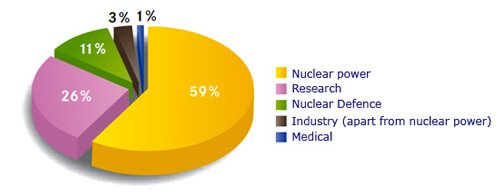Radioactive waste or recoverable materials?
The general public is more concerned about radioactive materials from nuclear power plants than any other kind. Their level of radioactivity far outweighs that of materials from hospitals, laboratories and industry!
It is widely believed that the threat from radioactive waste will be the same as now tens or hundreds of thousands of years in the future. Politicians and the media generally fail to mention that levels of radioactivity will have dropped dramatically by then. For example, the rays emitted by caesium-137, which make it so dangerous to approach a package of vitrified waste, will have been divided by 10 billion after the first thousand years.
Contrary to another widespread belief, no effort is spared today to ensure that this high-level waste has no harmful effect on the environment. Will the same be true for future generations 1,000 or 10,000 years from now? That is the question.
waste has no harmful effect on the environment. Will the same be true for future generations 1,000 or 10,000 years from now? That is the question.

Radioactive waste: percentages by volume
There are many sources of radioactive waste, more than half coming from the nuclear power industry.
© ANDRA
Recoverable materials and radioactive waste: Spent fuel from reactors is valuable for nuclear power utilities and the armed forces as it contains plutonium, a highly strategic material. One gram of plutonium generates as much energy as a tonne of oil and, once rid of its “bad” isotopes, plutonium can be used as an explosive in an atomic weapon.
We have just seen what becomes of plutonium. But what about materials that will ultimately be considered as actual radioactive waste destined for disposal? Most of their radioactivity will decrease over time, but how can we protect future generations from the small army of radioactive isotopes that will still be here thousands of years from now?
Recoverable or not, radioactive materials give good cause for concern. Planning hundreds and thousands of years ahead is a daunting task! But a solution can be found. The living world has always coexisted with natural poisons, such as lead, which do not disappear with time.
Managing radioactive waste: Radioactive waste management has come a long way since the “prehistoric” days of the 1960s when waste was dumped in the sea. In France, waste is managed by Andra, the national radioactive waste management agency. Research into the confinement of radioactivity has resulted in outstanding levels of performance today. Further research is aimed at reducing the volume and toxicity of radioactive materials. In France, this work is organised under an act passed in 1991 that other countries envy us. It was extended in 2006. Radioactive waste exists. Something must be done with it. Research will also improve a number of existing solutions. Rejecting all solutions would be the worst thing we could possibly do for future generations.
ACCES TO CHAPTERS : SUMMARY
– The waste issue : Waste and recoverable materials, reprocess or not nuclear spent fuels, what to do with plutonium ?
– Waste strategies : The solutions – wait, conditioning, deep geological storage, dilution.
– Waste inventory : A Waste panorama – The french inventory, origins of radioactive waste.
– Waste classification : Five waste categories – High, intermediate, low and very low level waste. Short or long lived.
– Reactor spent fuels : Characteristics of spent fuels – Composition, evolution with time of radioactivity, released heat, toxicity
– Spent fuel reprocessing : Production of hign level waste – Separation of uranium and plutonium from radioactive waste
– Waste management : Various management aspects – Radioactivity protection, transports, low level waste repositories, interim storages
– Geological repositories : Deep geological disposals – French CIGEO project, high level and intermediate waste disposals, spent fuels disposal projects
– Waste, Research and prospects : – Future improvements – Partitioning, transmutation, geological disposal, conditioning, interim storage